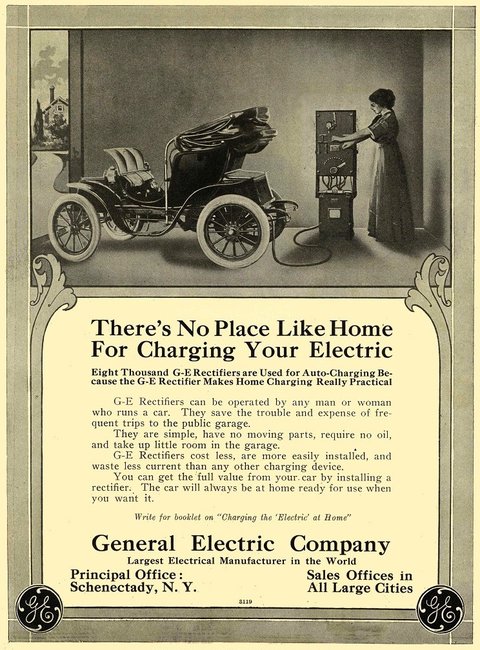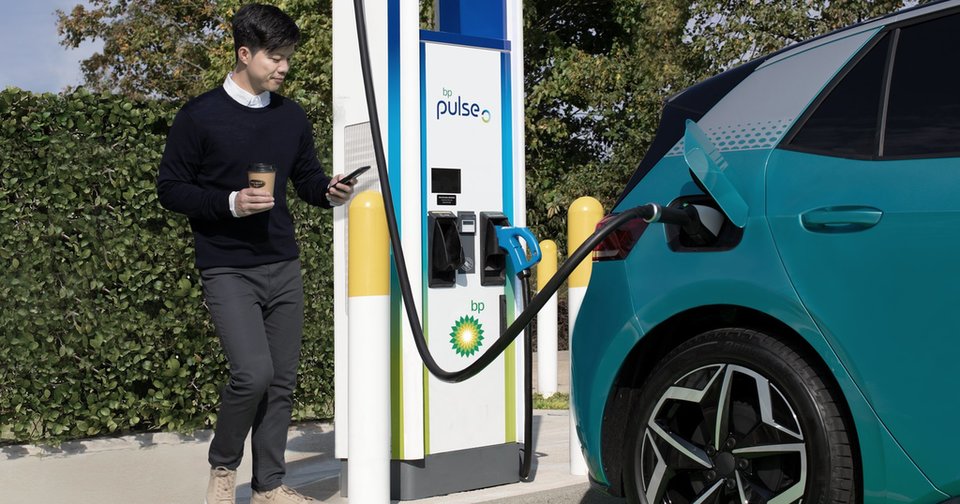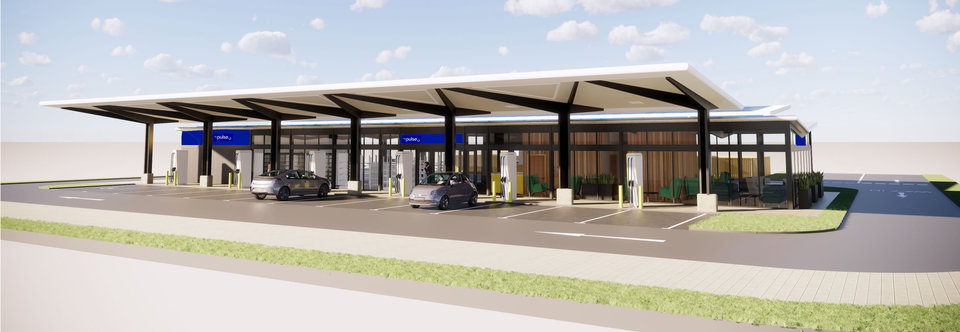
Public charging infrastructure and the pathway to 2030
In this section, bp pulse explain the charing infrastructure developments needed to meet the Government's 2030 EV deadline.
Continue reading

Tom Callow, Head of Insight and External Affairs, bp pulse
In my home office, I have a framed advert from a 1912 issue of the no-longer-published Automobile Trade Journal. It’s a General Electric advert for a home charging point (or ‘rectifier’ as it was then called), espousing the ease and convenience of charging your electric car at home. Around this time, there were a number of electric vehicles that could do as much as 100 miles or more on a single charge, and that could be recharged within a few hours. On the face of it, those numbers don’t seem much better than those of the Nissan LEAF – the world’s first mass-market electric car – which arrived in the UK about 100 years later. But the LEAF offered something that none of those very electric cars could: rapid charging.

Source: GE Home charging advert in Automobile Trade Journal 1912
It’s an over-used word, but the ability to charge quickly – adding around 100 miles of range in 30-45 minutes – really was a game-changer. Given their long charging times, very early EVs really were limited in their utility by their range on a single charge. The LEAF and its contemporaries helped to break that barrier, along with the providers of public rapid charging infrastructure, such as Chargemaster – now bp pulse, following its acquisition by bp in 2018. Before rapid charging arrived, the fastest you could have gained 100 miles of range would have been around 10 hours. Today, it can be as little as 10 minutes.
Data from Zap-Map shows that the UK’s public charging network currently offers around 50,000 charging points at more than 18,000 different locations, meaning there are more than twice as many places to charge your electric car than fuel your petrol or diesel one – and that’s before you start counting the UK’s 250,000 or so home and workplace charging points. So, of course, while you can refuel a car in minutes, you certainly can’t charge an electric vehicle at every one of those 18,000 locations in a matter of minutes. But what if you could?
While public charging infrastructure will always remain a mixed landscape, offering drivers ‘the right speed for the right need’. Still, there is a clear need to ensure that EV drivers and those looking to transition can have confidence in a ubiquitous network of ultra-fast chargers in every city, town and many villages, too. Anxiety about charging infrastructure often seems to focus on whether there are ‘enough’ charge points. Rather than looking at whether we have enough infrastructure by counting charge points, it’s much more helpful to consider whether we have enough infrastructure by capacity.
We know how many vehicles are on the road, and we broadly know when, where and how far they drive, so we can work out how much energy they will need to move them. Using that as the starting point, we can then look at the charging infrastructure that can most effectively deliver the energy they will need. Some commentators argue that we simply need to increase the absolute numbers and that this alone is the best measure of network quality. However, such a crude analysis doesn’t account for what really matters when it comes to making EV ownership as easy and seamless as possible for all UK motorists.

Using the number of charging points as the only barometer for progress is an outmoded and overly simplistic approach. For example, a single rapid or ultra-fast charger could easily be doing more work and delivering more energy than 50 or so on-street slow charging points.
For those who have access to off-street parking at home, a home charger will undoubtedly be the most convenient option for most, if not all, of their charging needs. But lack of access to home charging will not necessitate access to on-street charging. The majority of electric cars on the market are more than capable of the UK’s average weekly mileage, meaning that most drivers will have a choice about where they charge, and a weekly top-up on an ultra-fast charger may be all that many drivers need.
While on-street charging has its place and may be the best option for some drivers, the scale-up of a ubiquitous ultra-fast charging network is important for a number of reasons. Firstly, in terms of delivering the energy that electric vehicles need, rapid and ultra-fast chargers already appear to be delivering the majority of all public charging in the UK. On the bp pulse network, rapid and ultra-fast chargers make up around 20% of charge points but account for more than 75% of the energy supplied. Secondly, convenient and local ultra-fast charging will be vital for giving people the confidence to switch to electric vehicles, even if they rarely, if ever need it. There are too many ‘what if’ scenarios where slower charging alone would not be a good enough answer, from forgetting to charge overnight before a long journey to an overnight power outage resulting in a car not being fully charged.

"Convenient and local ultra-fast charging will be vital for giving people the confidence to switch to electric vehicles, even if they rarely, if ever need it."
Tom Callow, Head of Insight and External Affairs, bp pulse
Obviously ultra-fast charging won’t be needed everywhere you find a charging point. For a top-up while at the cinema, an ultra-fast charger might finish before the adverts do, so a slower charge would make more sense. But for charging quickly on a long journey, you probably won’t want anything less.
Off-street charging on forecourts, at charging hubs and in car parks may also present fewer challenges than on-street infrastructure when it comes to the practicalities of charging, as well as accessibility, and not just for those using them. Many on-street chargers are not installed in dedicated bays, meaning that they are frequently blocked by petrol and diesel cars and cannot be accessed for an EV driver in need – which may continue until the majority of vehicles are electric. And while on-street charging may appear convenient to those who want to charge outside their home, it may be less attractive to other users of footways, including those with impaired vision and users of wheelchairs or walking aids.
Slower charging can offer the benefit of greater flexibility for the energy system, especially with smart home charging, where drivers will be incentivised to charge at off-peak times, including via the recently passed Smart Charge Points Regulations. However, public charge points are not in scope of the regulations, and the extent to which consumers will engage in flexibility services – especially if the financial benefits are limited – remains to be seen.
Of course, when the first public charging units were installed, nobody knew how and when the EV market or charging technology would evolve. However, with a decade of experience on our side, we have a much better idea of what drivers need from public EV infrastructure.
In order to meet the demand of 2030 and beyond, it is clear that the UK will need a scale-up in public charging across the board and for all types, but we are focused on ensuring that fast comes first.